Punctuations term 1 & 2
PUNCTUATION
Hello learner, In this section, we are going to learn how punctuation marks can be used effectively to correct sentence faults in our use of the English Language. I hope this move will enhance your ability to construct clear and meaningful sentences without any difficult.
By the end of this section, you will be able to achieve the following if you attach seriousness to your studies:
- explain what punctuation is.
- discuss the importance of punctuation in Language.
- identify and use punctuation marks in English correctly.
What is Punctuation?
Punctuation is one of the most important aspects of written English, yet it is one that is taken the most lightly. It is, this feature of writing that gives meaning to the written words, much like pauses and changes in tones of the voice when speaking. An error in punctuation can convey a completely different meaning to the one that is intended. For example: a. Don’t stop. b. Don’t, stop.
The comma after the ‘don’t’ has made all the difference in the meaning of the words. Another example of how punctuation can change the meaning of a sentence is seen below:
a. Your pen, Mercy.
b. Your pen, Mercy?
Although the words are the same here, the two sentences mean completely different things because of full stop and the question mark.
Let us now define punctuation. It is the use of certain established marks or symbols within a piece of written text. Punctuation marks can also be seen as symbols which are used to separate and join units of sentence text. It is very important to know all the punctuation marks, have their meanings, and when to use them in order to produce a good piece of writing- and more importantly, to produce the correct message.
Importance of punctuation
The use of punctuation marks in written text makes meanings of sentences clearer.
The use of punctuation marks keeps words and sentences from running together and confusing the reader.
Punctuation enables the reader to determine whether a speech should be treated as a statement, command, exclamation of interrogative.
. Similarly, punctuation marks function to show readers that ideas or constructions are separate from those that follow them and sometimes indicate their grammatical boundaries.
. Punctuation helps readers to indicate that one grammatical structure of language is linked to the other.
It, further, helps us to phrase our readings, to observe units and breaks, and to help readers read with the right intonation. .
Also, punctuation tells us how to interpret some units of speech whether as a statement, a question or exclamation.
. Finally, punctuation helps us to express rhythm, stress and tone in spoken language.
Dear learner, we have seen that punctuation marks are important in written language because without them, a piece of writing would be difficult to read. We shall now look at the main punctuation marks of English and discuss their uses.
Before that answer the question below to
1. What is punctuation?
2. State three usefulness of punctuation.
The main punctuation marks of English
Below are the main punctuation marks of English:
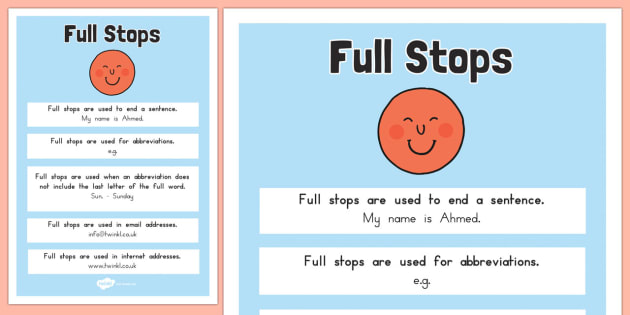
The Full Stop (.)
- It is used to mark the end of all sentences except questions and some exclamations. Here are examples:
1. Let’s have some dinner. Come here.
2. Dr. Abrafi-Adjei is the Head of Department.
3. Children are innocent.
- It is used after abbreviations. Examples are:
1. m. p. h – miles per hour
2. I.T – Information Technology
3. P. S. – Post Script.
etc. – et cetera
- The full stop is also used to mark the end of a sentence fragment, as in:
1. Are you well? – Yes, a bit.
2. Do you like sugar? Not much.
3. When are they returning? – Tomorrow morning.
- Again, the full stop is used in the initials for people’s names, as in :
1. Mr. J. A. Kufuor
2. Mr. J. J. Rawlings 3. Prof. J. E. A. Mills
4. Justice V.C.R.A.C Crabbe
5. Mr. J. D. Mahama
- We also use the full stop when an abbreviation consists of shortened
- word such as Rev., Prof. or Doc.
• Currently, the full stop is used in e-mail addresses and websites, as in:
1. www.kinderparadise.gh.com
2. jandfi200@gmail.com
3. www.gov.parliament@yahoo.com
- After an indirect question or polite request, the full stop is used, as in
1. He asked if the lecturer would return.
2. Will you turn your books to page 24.
Note that abbreviations such as TUC, TV, VC, BBC, GBC, BN, FBI, FDA UN, USA etc. are written without full stops.
Dear learner, there are other uses of the full stop and it will be revealing if you devote sometime to find the other uses.

The Question Mark (?)
This symbol is used to mark the end of a sentence which is a question. Here
are examples:
a. What’s your name?
b. Do you like this course?
c. Haven’t you finished eating?
d. He is not a child, is he?
The question mark is used in direct questions or quotations of a speaker, as
a. She says, “Will you like some more?”
b. He replied, “Do you have more to spare?”
We should also note that you put a question mark at the end of a question, even if the words in the sentence are not in the normal question order, or some words are omitted. Care is needed here as such a sentence can look, at first sight, like a statement rather than a question, as in:
a. You know he has completed school?
b. You are aware none of the students passed?
c. I hope you invited him?
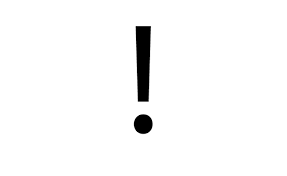
The Exclamation Mark (!)
This symbol is used to mark the end of interjections and sentences which show surprise or excitement. Here are examples:
a. I can’t believe!
b. Oh, no! Look at this mess!
c. Hey!
d. What a redeemer!
e. Femi!
f. Run!
From the above, we realize that the exclamation mark is also to emphasize
calls and command.
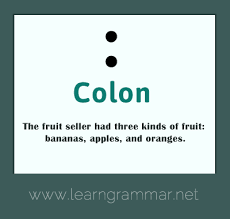
The colon (:)
This symbol is a pointing mark which indicates that the items which follow it are an addition, explanation or are details of an introductory item. Sometimes the colon indicates a break between two main clauses which is stronger than a comma but weaker than a full stop. Generally, expressions such as ‘as follows’, ‘the following’ and ‘as in’ are used. Here is an example:
a. The following lecturers have been promoted: Hariet okoh, Cynthia Logogye, Peter K. Afful, and Benjamin Yeboah.
- The colon is used to separate general statements from their specifics, as in:
b. These are his children: Nana Ama Ewusiwa, Nana Yaw Acquah Ewusi, and Nana Yaa Mfumaa Ewusi.
c. There are three most important things in order to live: air, water and food.
d. I used three colours: green, blue and pink.
- The colon is also used in front of an explanation or a reason, as in:
a. Nevertheless, the main problem remained: what should be done with the two men?
b. I decided against going away this weekend: the weather forecast was dreadful.
c. Kwame Nkrumah is remembered for his famous speech: “Ghana my beloved country is free forever. “
The colon is also used:
• After introductory headings, as in
a. Cooking time: about five minutes.
b. Start time: 11 O’clock.
c Break period: 9:20am
- In more formal writing, between clauses that are connected, as in:
a. Be patient: the next in the series will come.
b. Jesus is the Lord: He is the savior of the world.
c. My parents are dutiful: they perform their work diligently.
- In numerals, as in
7:30am and 22:10:72 and a ratio of 3:5
- In the titles of books, for example where there is a subtitle, as in:
a. The Dark Years: the Economy in the 1940s.
b. Transitivity in Political Discourse: A study of President kufuor’s
Inaugural Address.
Other uses of the colon
- To punctuate the salutation of letters especially in the US:
a. Dear Madam:
b. Your Majesty:
- To separate hours from minutes, as in:
a. 9:30am
b. 14:45GMT
- To separate chapter from verse, as in:
a. John 3:16
b. Psalm 1:1
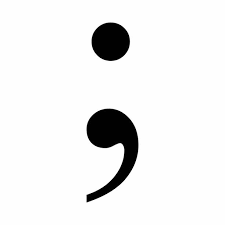
The Semi Colon (;)
- This punctuation mark is very useful symbol mainly used between clauses that are not joined by any form of conjunction, as in:
a. We had a wonderful day: sadly they did not.
b. He was a good friend; he is much missed.
c. Osei went there as promised; no one was there to meet him.
d. The engine roared into life; the propellers began to turn.
- It is also used to separate main clauses and subordinate clauses which are linked by such markers as on the other hand, certainly, in fact, on the contrary, incidentally, consequently, furthermore, get and further.
a. Fiifi is poor; yet he keeps taking new wives.
b. Abrafi is eloquent; in fact, everybody acknowledges that.
c. Budu is hostile; on the contrary Ali is friendly.
- The semi colon is used to separate items (not clauses) which have commas between them. Here are examples:
a. Each student had pencil, eraser, pen, jotter; and money, food, plates, and cutlery.
b. Araba bought oranges, apples, mangoes; and lettuce, carrot, cabbage and cucumber.
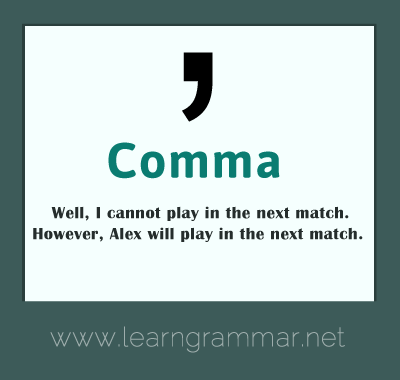
The comma(,)
The comma is a symbol used to mark a short pause between elements in a sentence. It has two major functions, that of linking and separating. Let us sow look at the specific uses of the comma
- It is used to separate words or phrases which occur in a list, as in:
a. The students bought honey, sugar, sardine and oil.
b. She sells fruits, vegetables, grains and cereals.
- It is also used to indicate international break when reading, as in:
a. They married for four years, but they divorced later,
b. Nana is diligent, yet he scores low marks always.
- It is, again, used as a separating device in a list of adjectives, as in
a. Baaba were a long, red, Chinese fabric.
b. We like drinking large, juicy forest coconut.
c. Dede and her parents live in a beautiful, old fishy village.
- We use the comma to separate relative clauses from main clauses, as in:
a. My father, who lived in Paris, came home last term.
b. The assassin, who killed the Abuakwa Member of parliament, has been apprehended.
- The comma is also used to separate adverbials such as ‘however’, ‘therefore’ or ‘unfortunately etc. from the rest of the sentence, as in:
• In vocatives, the comma is used to separate the name of a person or group being addressed from the rest of the sentence, as in:
a. Mr. Chairman, ladies and gentlemen, welcome to this programme.
b. Come on, Sylvia, be patient.
• Commas are used before question tags and after ‘yes’ or ‘no’ in short responses, as in:
a. It’s sweet, isn’t it?
b. Are you the father of Blay? – Yes, I am.
c. They are bakers, aren’t they? – No, they aren’t.
• In writing dates, the comma is used to separate the day of the month and the year, when the two members are next to each other, as in:
a. April 2, 2016 or 2nd April, 2016
b. May 25, 2000 or 25th May, 1977
Additionally, the comma is used to separate names from following titles, rank and qualifications, as in:
a. Dr. Amma Abrafi-Adjei, Head of Department, English Education.
b. Prof. K. B. Dickson, B. A. (Hons), Ph. D, (London)
C. Ms. Ellen Ayensu-Mensah, Head, Corporate Affairs, Grideo Ghana.
The Dash (-)
This symbol indicates a short break in the continuity of a sentence or it is used to extend a sentence. It is also used to point backward or forward to any word which is considered the subject, as in:
a. Air, water and food – these are the basic needs of every man.
b. J. A. Kufuor-he is forever praised.
Let’s now look at the specific uses of the dash.
- It is used to link a quotation and the person who made it, as in:
a. “I have fought the good fight; I have run the race, and I have kept the faith-Paul.
b. “All the word’s a stage, And all the men and women merely players” – Shakespeare.
c. “Power corrupt, and absolute power corrupts absolutely” – Acton.
- The dash can also be used to introduce a statement that adds to or explains what has been said, as in:
a. The thief took all valuables- paintings, jewelry, carvings and porcelain.
b. It is good to eat African fruits-avocado, mangoes, breadfruits, guava and tangerine.
- It also shows the omission of words or a sudden break-off in an utterance, as in:
a. “Sam helped Ayorkor, and -”
b. “She called to say – “
c. “We visited him, but-“
The dash can be used to emphasize a word or phrase, as in:
He was murdered last week-in cold blood.
- The dash is also useful in the introduction of an afterthought, as in:
You can go home with me I’d love it se m S. Parmits are caring-A few of them are rather inserative:
The dash is useful when we want to separate offers extra information from the rest of the sentence, as in a. Boots and shoes-all shapes, sizes and colours got burnt.
b. Cereals – millet, maize, wheat, rice – are energy giving foods.
Hello student, the usefulness of the dish as a punctuation mark is not exhaustive. You may find other uses of the dash in library books.
The Apostrophe (‘)

The Apostrophe (‘)
This punctuation mark is used with the letter ‘s’ to indicate that something belongs to someone or something. In other words it is used to indicate possession or contraction.
- Many spelling errors occur in the position of the apostrophe in relation the letter ‘s’
- Showing possession
i. A singular noun usually shows possession by adding ‘s to the singular form, as in:
a. The girl’s mother, Peter’s radio, the church’s secretary, the dog’s head Kofi’s ball etc. Can you add other examples?
b. A plural noun usually shows possession by adding – s’to the plural form ending in ‘s’.
Can you give examples? Good! Compare your answers to the following Teachers’ bag, men’s wear, women’s ministry, children’s service, colleges’ admission etc.
c. If a name or word ends in an ‘s’, we add an ‘s as in:
a Mr. Bicus’s children are proud.
b. The bus’s driver is safe.
c. Moses’s staff was powerful.
d. Charles’s project was rejected by the lecturer.
In modern usage, however, the ‘s’ is sometimes omitted, as in Bicus’ children, the bus driver, Moses’ staff, Charles’ etc.
Dear Learner, the misuse of the apostrophe is one of the commonest punctuation errors. The following instances do not take apostrophes
• Possessive pronouns This is ours, yours, theirs, hers, its et
• Abbreviations All the VIPS MDs, CEOs, MPS, MPs are here.
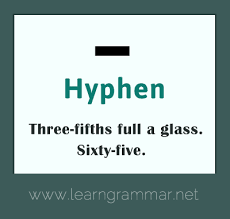
Hyphen (-)
This punctuation mark joins prefixes to words or joins two words in order to form compound words.
• The hyphen is used as the prefixed element in a noun, as in: anti corruption, Pre-Christian, pro-French, anti-British, Post-America, anti
virus, pre-school, well-deserved.
a. It is also used before dates or members. Here are examples: Pre 1990, pre-1614, post-1160
b. The hyphen helps us to differentiate meanings. Some words are difficult to understand without the presence of a hyphen. Here are examples:
i. Re-form to form again
ii. Reform – to change
iii. Re-cover to cover again
iv. Recover to become healthy after illness
So you can now see the great difference created in the above pairs of words? . In spelling and pronunciation, a hyphen is inserted if a prefix begins with the same vowel, as in: Co-operate, co-opt, re-examine, re-integrate, co-exist, co-author, co-efficient etc.

The three ellipsis dots indicate that something has been omitted in a clause, making it incomplete. Here are examples: a. Afotey entered the room and…
b. The building caved in killing….
c. Eroica travelled so…
- Sometimes, we use the ellipsis to guess the meaning from the context of a given sentence, as in:
a. You had better spell your name well or else…
b. Come for the punishment of…
c. We had better pay the fees on time else…
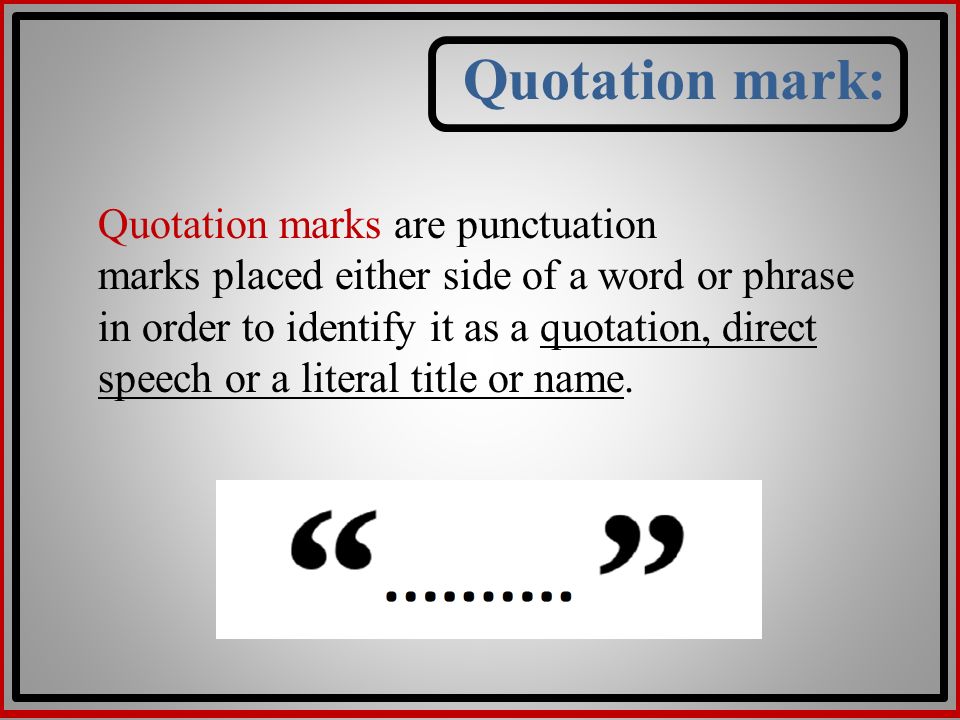
These are sometimes called ‘inverted commas’, and they are used to indicate direct speech. In direct speeches, the exact words of the speaker are enclosed in single or double quotation marks. Let’s have examples:
a. “Have you been faithful to your spouses?”, enquired the Pastor.
b. I have loved my wife sincerely, John replied.
C. “The flea is a fly”, said the teacher.
d. Naana assured him, “I will never divorce you, Joe”.
- The single quotation marks are sometimes used:
• To draw attention to a word, as in:
The word ‘table’ can be used as a verb.
b. The expression passed on’ is an indirect way of saying “one has died”.
To suggest that the writer wants to be distanced from a word, as in:
a. I don’t support this idea of ‘pall him down’
b. The so-called ‘family church’ has collapsed.
The Slash (/)
This symbol separates letters, words or numbers.
It is used to show alternatives, ratios and ranges, and in website addresses.
Let’s see examples:
a 2015/2016 academic year
b. Htp://www.glovoc.com e. District/Municipal/Metropolitan Assemblies
d. 80km/hr
e. He/she/it
Summary
It has been an insightful journey in this lesson. I hope you have been able to grasped most of the concepts we have treated in this lesson. We diligently discussed punctuation and its importance in writing, and also identified the various punctuation marks and their correct usage. We have learnt that punctuation helps us to separate one sentence from another. It also helps us to separate, link or enclose elements in a sentence, and to show omissions of elements. Overall, punctuation helps to clarify meaning. I believe the insight you have got so far will enable you to overcome the problem of punctuation errors as far as writing is concerned.
